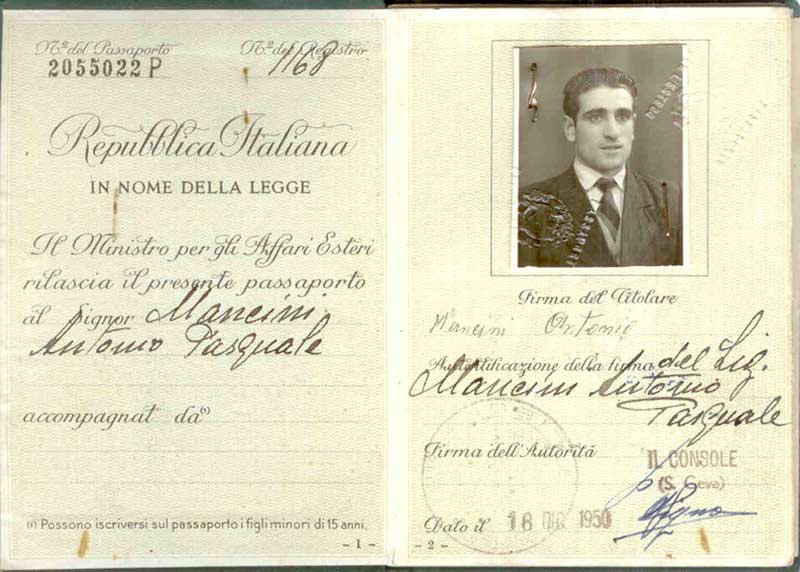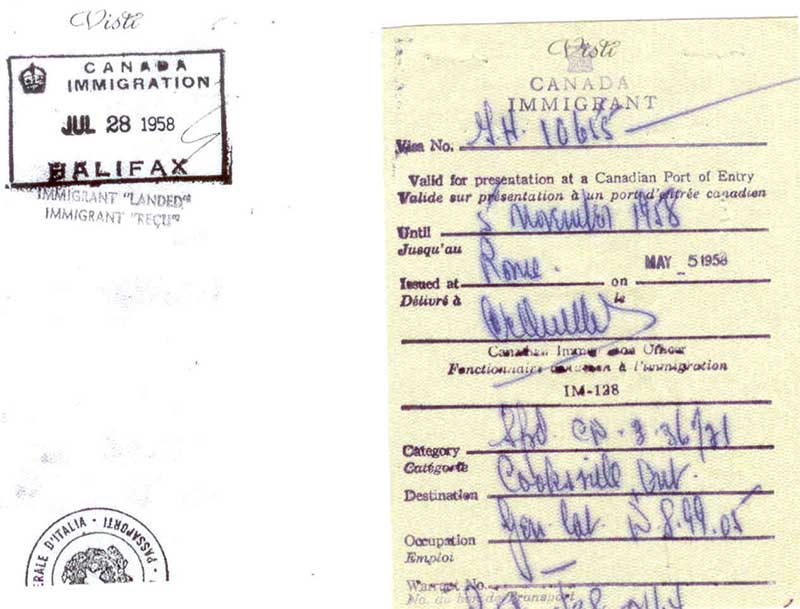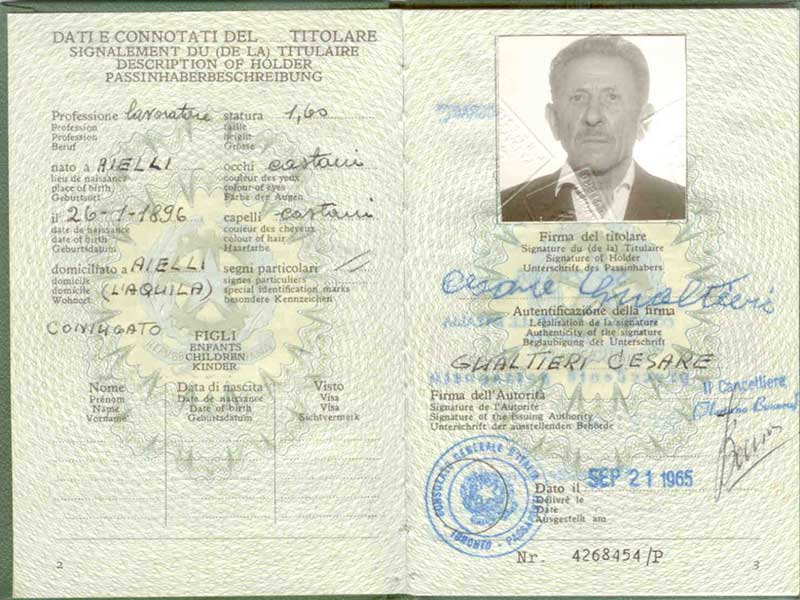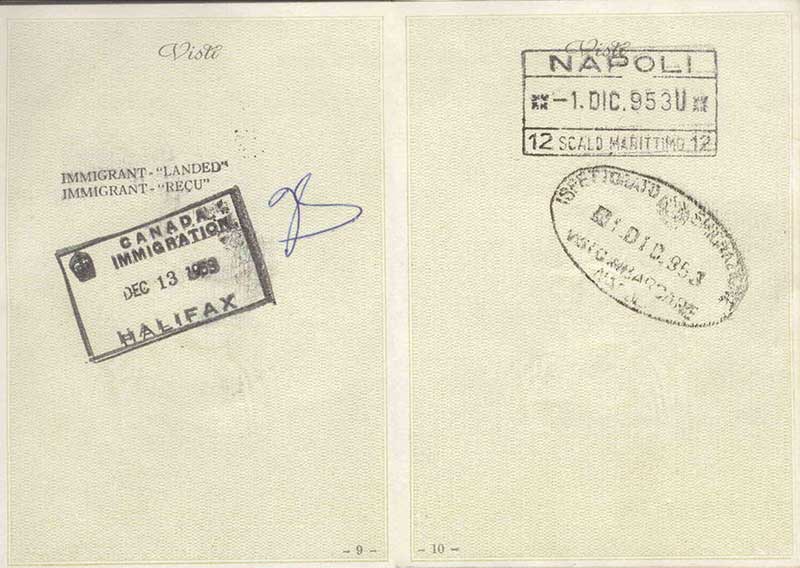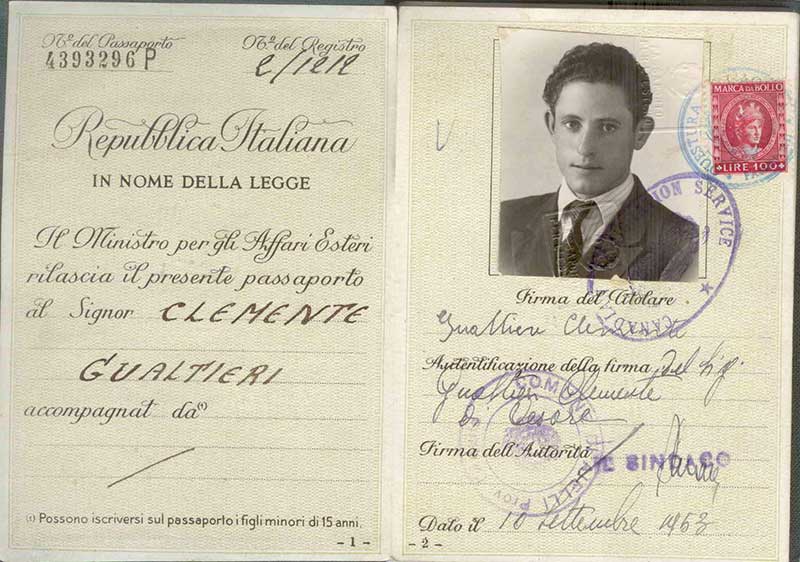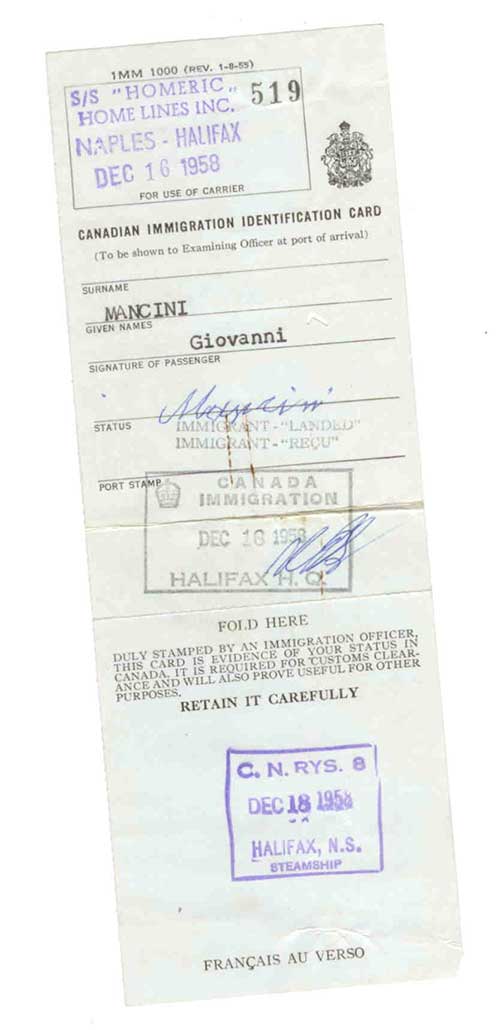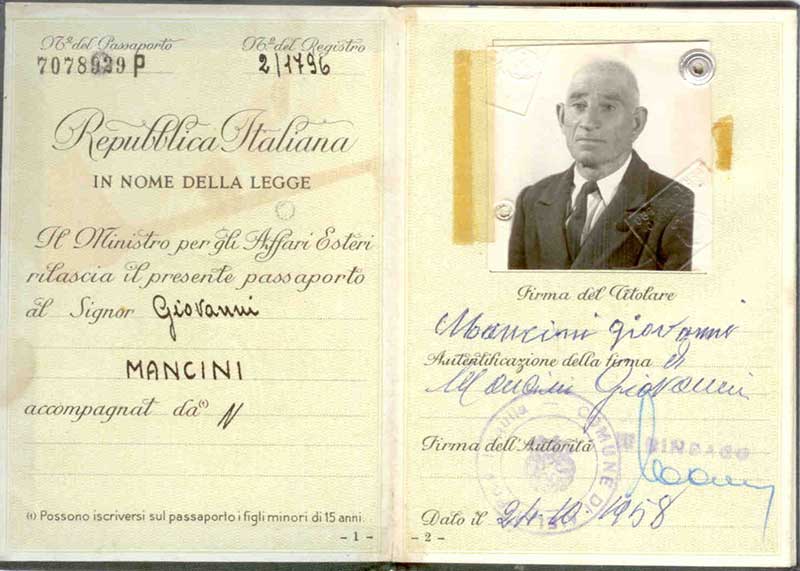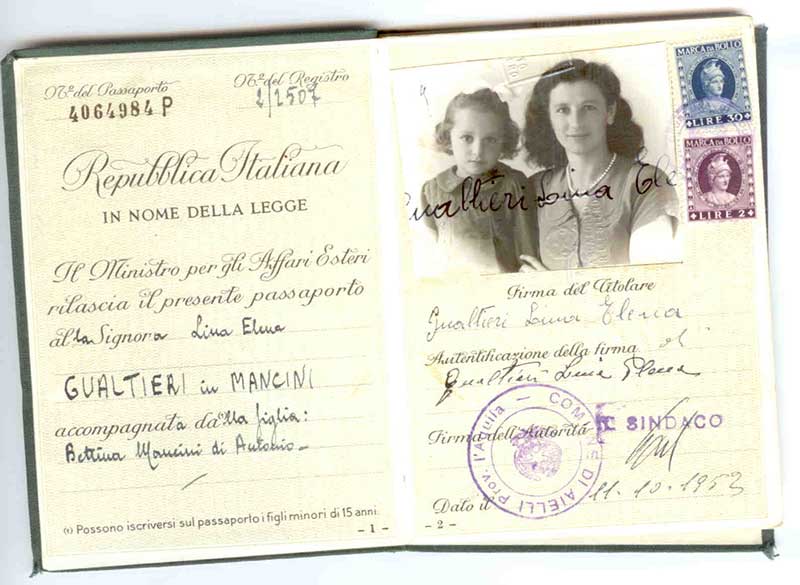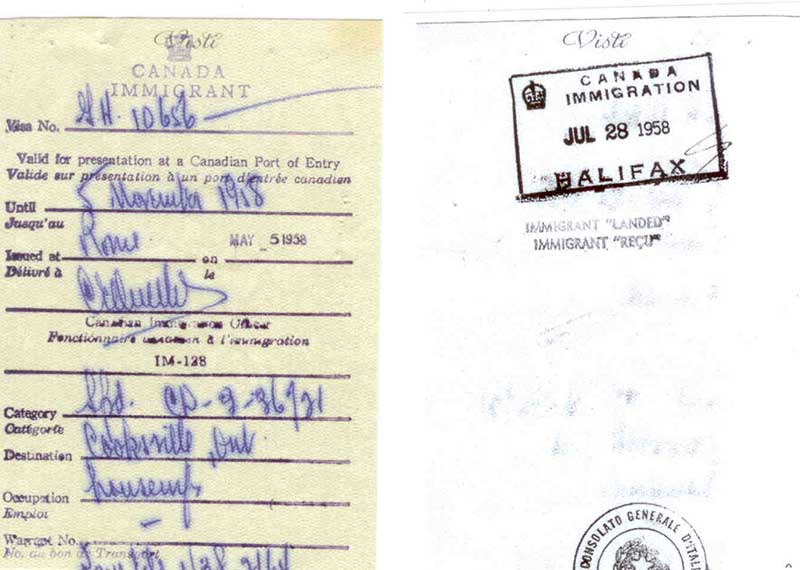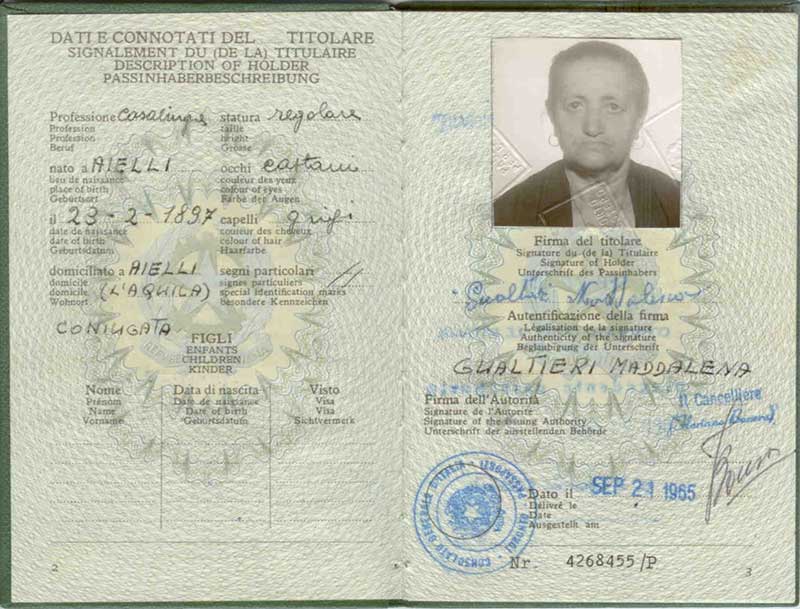Sobey Wall of Honour
Column
11
Row
26
MANCINI, Antonio (1923-1999) (My Dad)
As there was no work in Italy at the time, in October 1948, leaving behind a new bride (Lina) and infant daughter (Bettina), Antonio went to Brussels, Belgium to work in the coal mines. While there, a few years later Canada issued a call for immigration as they required workers to work on farms in Western Canada, so he decided to apply on his own to immigrate to Canada.
Having been accepted by Canadian Immigration along with a fellow coal-mine worker (Enzo Piccone, also originally from Italy) and leaving my mother and I behind in Italy, he and his friend began their journey to Canada, leaving Brussels on April 10, 1951, on the “Georgic” vessel (ID 4029) which carried 1,561 passengers, landing in Halifax on April 27, 1951. He then boarded a train to Montreal, and then on to Manitoba where he was met by the farmer he would be working for.
After a week or so, not very impressed with life in the Canadian West, he enlisted the help of a local Priest who was able to persuade the farmer to release him from his work obligation so he could go to live with his brother-in-law (eldest sister’s husband, Mario Angeloni) in Cooksville, Ontario, who had already emigrated in 1949. (Cooksville, part of the Township of Toronto at the time, is now part of the large city of Mississauga, and has the distinction of being Canada's first wine-making capital, according to signage posted in the Cooksville area of the city.)
Immigration requirements at the time were that if the government paid for your passage to Canada, you were required to stay and work at the destination location for a set period of time. Because he had paid for his own trip to Canada, and thanks to the assistance of the farmer (who was to have been his employer), who helped complete all necessary documents to allow him to travel to Ontario to join his relative, he was not required to fulfill his employment obligations. He then travelled by train to Cooksville where he joined his brother-in-law and found work at Cooksville Brick Company (“The Brickyard”) where he worked, alongside many other immigrants (including many paesani) for the next 15 years.
Together the brothers-in-law jointly purchased a home, and now working and having settled, he applied to have my mother and I join him, which we did in December 1952. A few years later in 1955, just down the street from the house he had co-owned, a new house was purchased and another daughter Cesarina was born same year. To this day, his 95-year old wife Lina still lives in this same home. He lived at this house until his death on September 16, 1999.
MANCINI (nee Gualtieri) Lina & LEARDI (nee Mancini) Bettina
Along with other relatives, on November 22, 1952, Lina and 4-year-old daughter Bettina, left their Italian home town of Aielli Alto, in the province of Aquila in the Abbruzzo region, and began their journey to join Antonio in Canada.
On November 23rd, they boarded the “Homeland” vessel (ID #4444 – 393 passengers) at the port in Naples, and at approximately 11:30 am, they departed Italy along with Antonio’s eldest sister Salvatrice and her four children Maria, Floriana, Luigia and Fernando who were also emigrating to join Mario Angeloni (his brother-in-law) in Cooksville. Also travelling with them was Lino Gualtieri, the14-year-old son of a relative from their home town who would be living with them in Canada, and who coincidently would one day marry Luigia and start their own family in this new land.
On the voyage from Naples to Genoa, both Lina and Salvatrice were seasick, and after arriving at the port in Genoa, all passengers disembarked for a half-day, before continuing on to Gibraltar. They were fortunate to feel better on the latter part of the voyage.
Lina recounts how on arriving at Gibraltar, the ship anchored in the water (not at the port) and vendors in small boats came alongside the ship to sell their wares to the passengers. Lina and Salvatrice purchased some head scarves which were placed in a basket on a rope which was raised up to them on the ship and they in turn took the goods and placed their money in payment back in the basket which was then lowered to the vendor.
Leaving Gibraltar, the non-stop voyage continued to Halifax with a great deal of seasickness felt by most of our family group – the only ones lucky enough to escape it were the two youngest, Bettina & Fernando, who were content to play on deck near their mothers! Lina recounts their days consisted of the same routine…waking up at 5:00 am and staying on deck until nightfall so as to settle their stomachs, since thanks to the seasickness, they did not eat much and couldn’t stay confined in their cabins. The only ones lucky enough to visit and eat in the dining room & cafeteria were the younger members of our group.
Among the passengers on the ship, we became acquainted with other Italians who were immigrating to Canada and going to the same area of Cooksville to join their relatives as we were. Gemma Della Costa and her two children, Romana and Diana, who a few years later in 1955, would become our neighbours (separated by one house) on Orchard Road (now called Rugby Road). Diana and I would also be classmates at the same elementary school of St. Catherine of Siena, through Grade 8.
At approximately 7:00 am on December 6, 1952, we arrived in Halifax. Somewhere along our journey to Cooksville, my mother recalls purchasing sliced white bread (known to this day as “English” bread) which they disliked as it did not compare with the bread they were used to eating in Italy. On arrival, my mother recalls not seeing very much of our new country as we were sent directly onto the train which she remembers had very uncomfortable wooden seats. We took this train to Montreal where we transferred to another more comfortable train for the last part of our long journey to Toronto. Approximately 24 hours after landing in Halifax, we arrived at Toronto Union Station, in the dark of night and travelled by taxi cab to Cooksville. On approaching the centre of town, my Mother remembers looking to one side of Dundas Street and seeing a 2-lane gravel roadway flanked by street lights on both sides (Franze Drive), where some of her husband’s relatives were to live a few years later.
Upon arriving in Cooksville, my mother remembers it mainly consisted of the 4 corners (crossroads of Hwy #5 & #10 or Dundas & Hurontario Streets) being the centre of town, a number of buildings situated in the immediate area of this intersection, much farmland with working farms and of course, the “Brickyard” (Cooksville Brick Company) which was the place of employment for a majority of the immigrants who settled in the area. At one time this company (which closed down in 1970) was the largest manufacturer of bricks in Canada.
My mother remembers arriving at our new Canadian home (a house jointly purchased for both families by my Dad and his sister’s husband) to find it full of ‘boarders’, 10 men in total, most of them being Dad’s cousins, and all of whom had emigrated recently to Canada as well. Adding all of the women and children who had just arrived, there were approximately 20 people who would be sharing the home for the next 2 years until other homes were purchased on arrival of other family. To this day, my Mother has never regretted the relocation to a strange new land.
To mark the 50th anniversary of our arrival in Canada, in October of 2002 we revisited Pier 21. I, along with my mother Lina and cousins Floriana & Luigia (all from the original group) as well as a few other family members who were born in Canada, namely my sister Cesarina (Rina), son Marc, and my cousin Luigia’s daughter Liana, made the trip to Halifax. On entering the main area of the building, both my mother and cousins immediately recognized the room and began to tell the rest of the group what they remembered from their experience 50 years prior. They remembered the ‘big (shed) room’ where they were held before being ushered onto the waiting train with the wooden seats which they remembered as very uncomfortable. Unfortunately, being very young at 4 years old, I did not have any memories that I could relate to but still found the visit to Pier 21 experience very moving, knowing that I once passed through this place.
GUALTIERI, Clemente (1929 – 2002) (My Uncle)
At age 24, Clemente left Naples, Italy on December 1, 1953 by ship and landed in Halifax on December 13, 1953. He travelled to Cooksville to be with his sister Lina and her family. His younger 19-year-old brother, Antonio had emigrated to Canada earlier that year in September, landing at the local Toronto airport, now known as Lester B. Pearson.
His sister Lina had applied to have both brothers join her and her family in Canada and they were meant to both have come by air in September, but only Antonio came as Clemente needed to remain behind in Italy to finish the family farming duties, so he delayed his departure a few months. Arriving with only the clothes on his back, Clemente liked Canadian living very much, and both brothers were so taken with life in Canada that in 1962, they took a risk and began a construction company which snowballed into other companies he owned spanning 40 years until his death in 2002.
GUALTIERI, Cesare (1896 – 1976) & GUALTIERI (nee Polla) Maddalena (1897 – 1977) (My Maternal Grandparents)
Cesare at age 62 and Maddalena at age 61, travelled from Naples, Italy to join three of four children, my mother Lina, Clemente and Antonio, who were already living in the same neighbourhood in Cooksville, arriving in Halifax on July 28, 1958 and then by train to Toronto. The oldest sibling, Angela, remained in Italy until the summer of 1971 when she, along with her husband Tommaso Marinucci, also emigrated to Canada.
Not knowing what they would find in the new land, Maddalena brought with her, some items she deemed necessary, all hand-made, and some of which I still have in my home today. A copper bed-warmer (scallaletto), which is a container with a long handle and holes on the lid, used to hold hot coals and placed between bed sheets, a large copper pasta strainer, a garden hoe (zappa) and a 2-person hand saw. This was not the first time Cesare had been to Canada. He had originally been both here and in the United States for a 5-year period from 1923 to 1928. At that time, three of Maddalena’s brothers, Lorenzo, Giuseppe and Domenico Polla who resided in Auburn, New York were unsuccessful in having him admitted into the US, so an acquaintance of theirs, living in Canada completed the necessary paperwork for Cesare's successful emigration to Canada.
When he did arrive, as there was no work available and not having proper documents to travel to the US, he proceeded to enter the USA by underground means and began working there. After some time, wanting to bring his family over, he returned to Canada to speak to the acquaintenace who had originally helped him in getting to Canada, and then he returned to the US, (again using underground means) only this time was caught by the US authorities and spent approximately one month in a US prison. Because of good behaviour while there, he was released after his brothers-in-law paid $500, which amount was returned to them, after Cesare was deported back to Italy, as he was not a Canadian citizen at the time. His dream was to return to Canada but with a growing family at the time it was difficult.
Maddalena would recount this often...that when Cesare was in Canada in the 1920’s, he wrote and told her he would eat chicken meat quite often, and when she emigrated and saw the abundance of meat to be had, she commented… ”that’s why he didn’t send back too much money…he spent it on meat which he ate very often” (meat was an infrequent treat for them in Italy as it was in short supply during that time).
MANCINI, Giovanni (1886 – 1967) (My Paternal Grandfather)
A widower since 1944, he emigrated to Canada at the age of 72 to be with five of his six children (daughters Salvatrice Angeloni, Giuseppina Iacobucci and Maria Giamberardino, and sons Antonio and Alfredo) who were all living in the same Cooksville neighbourhood. Travelling alone from Naples, he arrived in Halifax on December 18, 1958.
Once landed, he was stuck in Halifax due to a misunderstanding that occurred between the travel agent in Italy and his eldest son Angelo with whom he had been living there; Angelo is the only one of his six children who never emigrated to Canada (deceased in 1992). This resulted in him not having paid train travel for the balance of his journey to Toronto, so his youngest son, Alfredo, travelled to Halifax to accompany him to his new home in Cooksville.
He lived in Canada with his children until his death on May 14, 1967.
